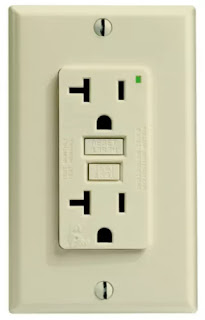How To Troubleshoot A Receptacle (Outlet)
While there is a chance that you’ll have to bring in an electrician, in many cases, the problem behind a non-working outlet can be resolved by the homeowner. First, a bit of information about a outlet:
The vertical slots in the outlet are called “shutters,” and the small hole beneath each set of shutters is the “ground.” Most outlets will accept either 2-prong or 3-prong plugs. If your home has older wiring, the third hole (the “ground”) may not be present. Keep this anatomy in mind as you try the following troubleshooting tips.
First you need to determine what kind of outlet you're dealing with. A half-hot outlet allows you to plug in a lamp, turn it on, and then control the lamp from a light switch. If there is a switch in the room that does nothing it could possibly control a "lamp outlet". Verify this before continuing.
GFCI
If it’s a GFCI (Ground Fault Circuit Interrupter) outlet, it might have shut off automatically and need to be reset. GFCIs are usually installed near areas where water is nearby (bathroom and kitchen sinks). Water and electricity don't mix very well. Unfortunately, GFCIs can often stop working even if it hasn't been in contact with water. But it’s an easy fix: Just push the small rectangular button on the center of the outlet and it will reset the GFCI. Then, plug in your phone charger or something else that you know works and see if it comes on.
If you lose power to an outlet, the majority of the time, other outlets nearby will also lose power. Test the outlets in the room to see if they’re working. If other outlets don't work make sure what you are plugging in isn't broken. If the problem isn't what you're plugging in, it could be at the breaker panel, which we’ll inspect next.
If the power was restored to the outlet after you flipped the breaker, you might have overloaded the circuit. An overloaded circuit can happen if you plug too many things (especially small heaters or power tools) into the same circuit. When that happens, the circuit breaker will flip because you’re attempting to draw more electricity than the circuit can handle. Unplugging some things from that outlet can determine if you have a overloaded circuit.
A circuit short can happen if the circuit has been interrupted or the wrong wires are touching each other. A short circuit can be deadly or even cause a fire in your home. If the breaker flips again after you’ve reset it and you don’t have anything plugged in leave the breaker off and call an electrician.
A loose wire connection can cause a outlet to not receive enough power. If you’ve gone through the previous troubleshooting steps but you still don’t have power to the outlet, there’s a chance it’s due to loose wires. If you do not feel comfortable touching the wire connection this is the time to call a electrician near you to help out.
Although it isn’t common, an outlet can burn out or otherwise go bad and quit functioning. If you’ve followed the previous steps without success, you might want to consider replacing the outlet. Once again, if you intend to do it yourself, make sure the breaker switch that powers the outlet is in the OFF position. Then, remove the outlet cover and then disconnect the wires from the old outlet with a screwdriver. Reverse the process to install the new outlet, making sure the wires are connected as described in the previous step.
If you still have no power at the outlet, it’s time to call an electrician.
Home wiring is a complex system, and electricians have special equipment and testers to help them locate electrical problems that are difficult to pinpoint otherwise. If the problem was not remedied by the previous steps, it’s a good idea to have an electrician take a look.





Comments
Post a Comment